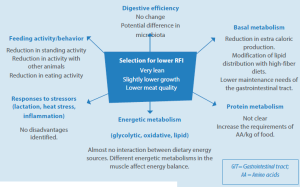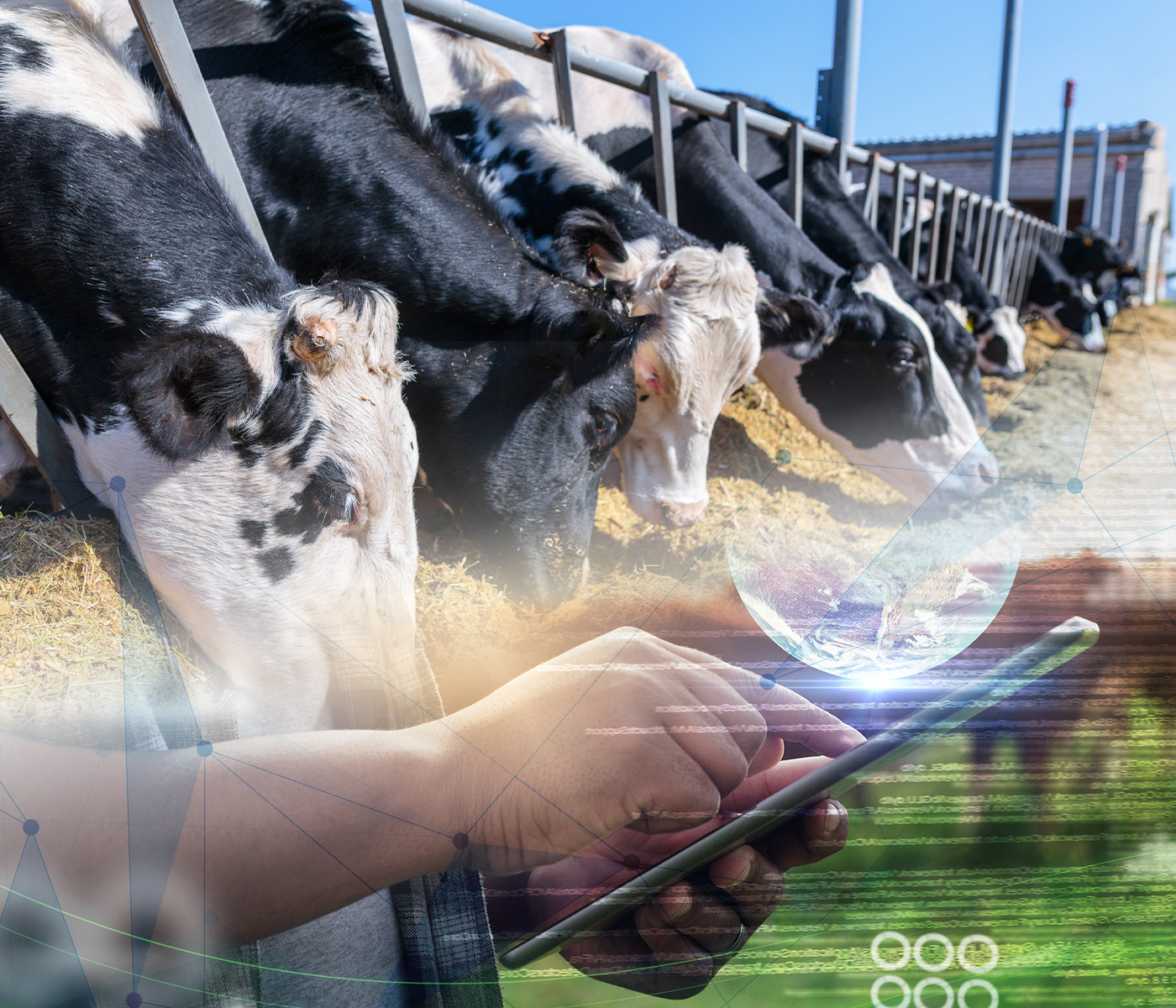Controlling residual feed consumption is maintaining balance.
The progress of the animal production sector has delivered noteworthy enhancements in the efficiency of food consumption, owing to advancements in genetics, technology, and management practices.
|
Livestock production, being considered a business aimed at obtaining one or several products, requires the use of controls that allow evaluating current results in order to determine whether objectives have been achieved, correcting deviations, promoting strategy changes, and formulating new plans. |
Production records can be defined as:
“A systematic format for gathering information about the origin, management, behavior, and destination of animals, with the goal of assisting the producer in decision-making” (Refer to Production Records for Decision-Making on the Ranch- *spanish content).
Supplying feed to animals constitutes the main cost across all animal production systems. Nonetheless, the benefit lies in its straightforward quantification.
Among the methods of regulation is the computation of “Residual Feed Intake” (RFI), delineating the variance between projected and actual feed consumption. This calculation takes into account:
![]() body size
body size
![]() weight change
weight change
![]() milk production
milk production
rendering it a valuable metric for comprehending feed efficiency.
Practical trial on residual feed intake
For instance, during a study, Sainz and Paulino (2004) from the University of California, Davis, discovered that:
![]() Two calves with identical intakes (7.43 kg) exhibited a difference of more than 50% in their average daily gain: 1.51 kg versus 0.98 kg, respectively.
Two calves with identical intakes (7.43 kg) exhibited a difference of more than 50% in their average daily gain: 1.51 kg versus 0.98 kg, respectively.
Evidently, the more efficient animal would yield significantly higher profits.
![]() However, in the same trial, two animals with nearly identical growth rates (1.5 kg/day) had significantly different feed intakes (7.43 kg versus 9.22 kg/day).
However, in the same trial, two animals with nearly identical growth rates (1.5 kg/day) had significantly different feed intakes (7.43 kg versus 9.22 kg/day).
Obviously, the animal with the same growth rate and lower feed intake would be much more profitable.
This phenomenon arises when animals fail to ingest sufficient feed to fulfill their nutritional requirements, potentially resulting in adverse impacts on their health, growth, and overall productivity.

Figure 1. Impact of reducing RFI on major physiological functions
The utilization of nutrients by an animal encompasses intricate biological mechanisms and interactions within its environment (Figure 1). Furthermore, this process is further complicated by the strong correlation between feed intake, body size, and production level.
To address these challenges and establish a connection between feed intake and production system efficiency, several metrics (Archer et al., 1999) can be categorized as follows:
![]()
gross efficiencies
![]() partial growth
partial growth
![]() maintenance
maintenance
![]() maternal/offspring
maternal/offspring
![]() RFI
RFI
RFI is a measure of feed efficiency in beef cattle which is independent from: production level, body size, and growth rate.
![]() It serves as a valuable metric for exploring the physiological mechanisms that underlie variations in feed efficiency.
It serves as a valuable metric for exploring the physiological mechanisms that underlie variations in feed efficiency.
Physiological factors of variation
Five physiological processes contribute to its variation:
![]() feed intake
feed intake
![]() digestion
digestion
![]() Metabolism (including variations in body composition)
Metabolism (including variations in body composition)
![]() physical activity
physical activity
![]() thermoregulation
thermoregulation
| In certain studies where calves were categorized according to RFI levels, scientists noted that heat generation from metabolic processes, body composition, and physical activity accounted for 73% of the variation in RFI. |
The distribution of variation in these processes is elucidated by:
![]() Protein turnover,
Protein turnover,
![]() Tissue metabolism, and stress (37%)
Tissue metabolism, and stress (37%)
![]() digestibility (10%),
digestibility (10%),
![]() Heat increment and fermentation (9%),
Heat increment and fermentation (9%),
![]() Physical activity (9%),
Physical activity (9%),
![]() Body composition (5%); and
Body composition (5%); and
![]() Feeding patterns (2%).
Feeding patterns (2%).
 However, explanations for identified physiological mechanisms are based on very few studies and generally have small sample sizes.
However, explanations for identified physiological mechanisms are based on very few studies and generally have small sample sizes.
Among various considerations, the genetic component contributing to the variation in these physiological processes remains unresolved. Several studies have indicated that the intricacies of the involved physiological processes are linked to hundreds of genes.
|
Residual feed intake is an individual record, obtained from long-term feeding trials (at least 70 to 84 days), where animals are housed either in individual pens or in groups.
It emphasizes the need to perform measurements for both daily food offerings and rejections, in addition to daily weight gains. In group settings, these measurements are typically averaged. |
Research has provided evidence indicating substantial individual variability in expected feed intake, considering body weight and growth, in both higher and lower ranges.
|
|
Measurement techniques
Recently, techniques using electronic devices that identify each individual animal have emerged.
Individual feed intake is assessed in animals housed within group settings. While this approach can be adopted, slight disparities have been noted when contrasting these two housing methodologies.

Therefore, obtaining RFI data is labor-intensive and costly, which has limited its dissemination as a measure of feed efficiency.
Ad libitum intake is achieved by offering a diet in quantities exceeding expected intake.
 However, the amount of excess can influence the intake of certain diets and raise questions about the definition of ad libitum intake. In trials where the objectives were to measure feed intake, milk production, and composition of lactating cows by offering total mixed diets at different excess feed levels.
However, the amount of excess can influence the intake of certain diets and raise questions about the definition of ad libitum intake. In trials where the objectives were to measure feed intake, milk production, and composition of lactating cows by offering total mixed diets at different excess feed levels.
In one of the experiments, three diets varying in forage type and quantity were analyzed, with all three trials featuring lactating Holstein cows:
[n = 27 (trial 1) or n = 16 (trials 2 and 3)]
The interventions encompassed diverse feed quantities to achieve a daily per-cow rejected feed volume of either 5% or 30% of the provided feed. Additionally, for trial 1, a rate of 15% was incorporated.
| The actual rejection rates achieved were very close to the target values, averaging 7.1%, 15.0%, and 28.3%, respectively. |
 There was no variation in dry matter intake between treatments for cows fed with either of the two low-forage silage-based diets (trial 1), or for those fed a chopped hay-based diet (trial 2).
There was no variation in dry matter intake between treatments for cows fed with either of the two low-forage silage-based diets (trial 1), or for those fed a chopped hay-based diet (trial 2).
Nonetheless, the intake of dry matter was 39% greater than the highest feeding rate for cows fed a high-forage silage-based diet (trial 3).

 Neither milk production nor the composition of the feed refused per cow per day differed with the treatment.
Neither milk production nor the composition of the feed refused per cow per day differed with the treatment.
|
Final considerations Excessive feeding quantities can lead to increased feed intake. It is essential to evaluate the applicability of the 10% rejection rate recommendations for maximum intake in research and commercial feeding contexts across different diet types, feeding systems, and climatic conditions. |
In the next issue we will delve deeper into additional aspects concerning residual feed intake.
You may also like to read: “Improving feed efficiency in dairy cattle.”



 This, along with the fact that individuals of the same body weight require significantly different amounts of feed for the same level of production, establishes the scientific foundation for measuring RFI.
This, along with the fact that individuals of the same body weight require significantly different amounts of feed for the same level of production, establishes the scientific foundation for measuring RFI.








